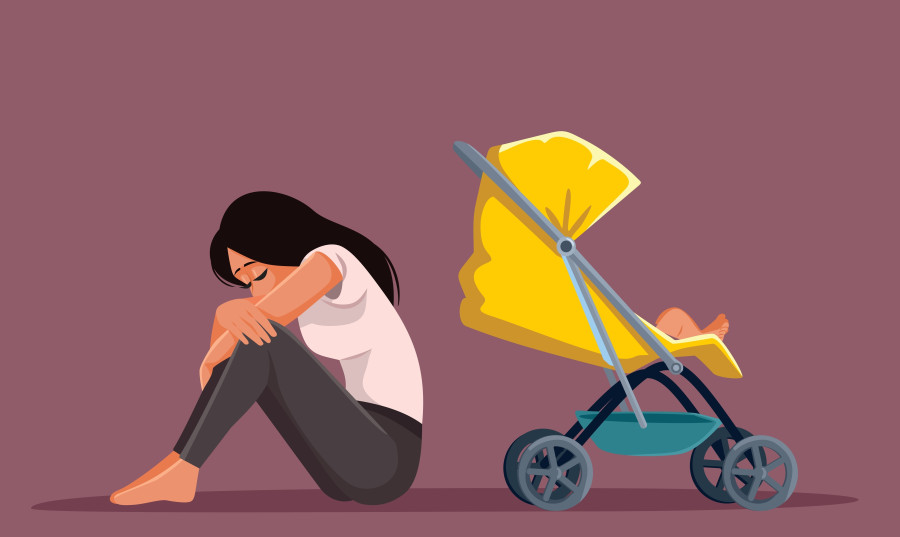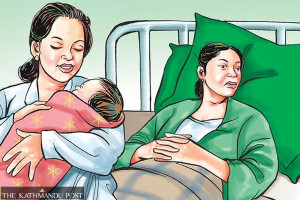Columns
Prioritising postpartum mental health
It not only harms mothers but can also impede the child’s cognitive and emotional development.
Dr Pallavi Koirala
Motherhood is a deeply appreciated and respected period. However, bringing a baby into the world is an emotionally intense and physically draining experience. The postpartum period is filled with feelings: happiness, anxiety, excitement, nervousness and uncertainty. Experiencing such highs and lows in the first few weeks or months of childbirth is considered normal, as women’s bodies undergo significant hormonal and physical changes.
Managing a newborn’s sleep schedule, breastfeeding or pumping and maintaining proper nutrition can be overwhelming. These challenges, though part of the postpartum experience, can take a toll on mothers’ mental well-being. For many mothers, feelings of depression and anxiety can cloud precious bonding time with their babies. So, the support of family and husbands becomes crucial in nurturing not only the newborn but also the mother.
The feeling of sadness, worry, anxiety, or tiredness within a few days of childbirth, which most women experience, is known as “postpartum blues”. Usually, it goes away with time, but if the feelings persist for more than two weeks, it is referred to as postpartum depression (PPD). Postpartum depression is a severe mental health condition that is marked by persistent sadness, anxiety, persistent crying, tiredness or loss of energy, disturbed sleep and changes in appetite. It is a silent battle many mothers struggle with two to eight weeks after birth, or in some cases, even up to a year after delivery. Feelings of detachment from your baby or partner, as well as thoughts of harming your baby, may even occur in postpartum depression.
Maternal mental health problems are gradually being considered a major public health challenge globally. A recent meta-analysis showed that about 20 percent of mothers in developing countries experience clinical depression after childbirth. Suicide is a significant cause of death among pregnant and postpartum women. Evidence indicates that providing treatment for the depression of mothers leads to improved growth and development of newborns and reduces the likelihood of diarrhoea and malnutrition among them.
In Nepal, postpartum depression is a significant public health issue that remains unrecognised, unreported and untreated. The rates are higher—15.6 percent during pregnancy and 19.8 percent in postpartum—making maternal suicide one of the leading causes of death among women of reproductive age. Various factors might trigger this situation, including cultural pressures and expectations. Women in rural areas face demands to resume household chores shortly after childbirth, which does not give them adequate time to recover. The lack of support from family members, insufficient health-seeking behaviour and geographical barriers further exacerbate the effects of postpartum depression on breastfeeding, mother-baby bonding and family dynamics. Due to the deep-rooted stigma in society, women with postpartum depression often do not seek professional help. Mothers and their family members usually fail to recognise the symptoms and remain unaware of the condition due to a lack of health education and awareness during pregnancy.
Although postpartum depression is plaguing our mothers worldwide, it is treatable. Seeking help is a sign of strength, not weakness. PPD can affect any woman regardless of background or circumstances. Untreated PPD not only harms the mother but can also have lasting effects on the child’s cognitive and emotional development.
In Nepal, where discussing mental health is still surrounded by stigma and silence, addressing PPD requires a multi-layered approach. We must begin by normalising conversations about mental health within families and communities through awareness campaigns. Mental health counselling should be incorporated into antenatal visits, targeting not just pregnant women but also their caregivers to ensure early detection and timely intervention. Emotional encouragement, shared responsibilities, and an understanding environment from close family members can help mothers overcome feelings of isolation and being overwhelmed.
Community-level interventions are equally important. Equipping the Female Community Health Volunteers (FCHVs) and primary health care workers with knowledge and tools to identify and support women showing PPD signs in rural areas can bridge the gap in mental health care access. Additionally, helpline services like 1166, which offer confidential psychological support, can be lifesaving to women who hesitate to speak out in person.
Evidence from a trial in Pakistan showed that cognitive behaviour therapy (CBT), when delivered by community health workers to pregnant women in their third trimester of pregnancy, significantly reduced the incidence of PPD. Such methods could also be adapted in rural settings where access to mental health services remains limited.
Ultimately, cross-sectoral approaches that address broader social determinants of health are required to address PPD. Strategies such as poverty reduction, gender equality, women’s empowerment and improved access to education contribute to stronger mental health outcomes. An integrated approach that includes psychological counselling, pharmacological treatment, strong social support and lifestyle changes plays a huge role in reducing PPD.
We must unite as health professionals, families, communities and policy-makers to ensure no mother suffers in silence. With the proper support, new mothers can heal and find hope.




 15.12°C Kathmandu
15.12°C Kathmandu















